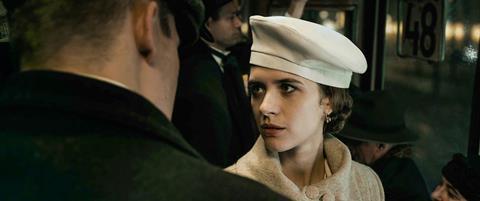Back to Vienna of old with Stefan Ruzowitsky’s propulsive post-war thriller

Dir: Stefan Ruzowitzky. Austria / Luxembourg 2021. 99 minutes
The Third Man meets Se7en amid the chaos of post-First World War Vienna in atmospheric serial-killer thriller Hinterland, a welcome return to the limelight for director Stefan Ruzowitzky some 13 years after his The Counterfeiters landed the international Oscar. Built around a powerhouse performance by Murathan Muslu as a battle-scarred veteran enmeshed in a nightmarish murder-mystery, the film imaginatively deploys green-screen technology to conjure off-kilter visions of the Austrian capital a century ago.
Hinterland successfully avoids being swallowed up by its own aesthetic via the narrative’s propulsive momentum and the magnetic central performance by Murathan Muslu.
Premiering at Locarno in the audience-oriented Piazza Grande section, this fast-moving genre offering crams considerable incident into its 99 minutes. Despite the somewhat bland title — the slightly stronger ’Homefront’ has been floated as an English-language variant — the picture boasts solid box-office prospects in German-speaking territories with considerable potential for streaming and small-screen exposure, perhaps prelude for further adventures featuring compelling protagonist Peter Perg.
A respected police-officer and criminologist of affluent background in his civilian days, Perg returns to Vienna in 1920 a glowering, hulking shell of a man, physically and mentally wrecked by more than two years’ imprisonment in a Russian POW camp. Having started the war fighting for a huge ’fatherland’ presided over by a seemingly immortal emperor (Franz Joseph, whose 68-year reign ended with his death in 1916), Perg now finds himself adrift in a newly republican Austria of drastically reduced size and raging social tumult.
As he struggles with his personal demons — he can’t yet bring himself to visit his wife and child, evacuated to safety in the nearby countryside — Perg realises that the inventively murderous ’Beast of Vienna’ is picking off his own former comrades from the Russian camp. Potentially the next victim, potentially even a suspect himself, Perg must dredge up his long-dormant cop skills to track down the killer…
Working with visual-effects wizard Oleg Prodeus and set-designers Andreas Sobotka and Martin Reiter, Ruzowitzky conveys Perg’s extreme sensory disorientation by means of radically expressionistic CGI backdrops. In this Vienna — where now-long-vanished landmarks such as the grand railway stations and the gigantic Rotunda are still part of the cityscape — there are no right angles, no plumb lines. Everything is menacingly cock-eyed and there seems to be no primary colours in cinematographer Benedict Neuenfels’ dunnish palette of muted sepia-infected tones.
Ruzowitzky wears his stylistic influences on his sleeve, drawing heavily from the groundbreaking German-language cinema of this era — most famously Robert Wiene’s The Cabinet of Dr Caligari (1920), but also the works of Vienna-born Robert Reinert such as Nerves (1919); the bottom half of a Reinert poster can be glimpsed in a café scene. Shadows and echoes of the most famous Vienna-film, Carol Reed’s The Third Man (1949), are inescapable — in both films the main female character is named Anna, here a young pathologist (Liv Lisa Fries) with whom Perg strikes romantic sparks. Whereas the action of the Graham Greene adaptation (in which tilted Dutch angles abound) famously culminates underground in the city’s giant sewer tunnels, Hinterland locates its tense shootout climax far above the city, in the bell-tower of St Stephen’s Cathedral.
It takes a little while to adjust to the film’s strong and deliberately oppressive stylistic approach, but Hinterland successfully avoids being swallowed up by its own aesthetic via the narrative’s propulsive momentum and the magnetic central performance by Muslu. A native Viennese of Turkish parentage, Muslu has compiled an impressive stack of credits on big screen and small over the past half-decade, including Ruzowitzky’s Cold Hell (2017) — another Vienna-serial-killer exercise — and the Frankfurt-set Netflix six-parter Skylines. Perg is a testing, meaty role and Muslu rips into it with steely aplomb, successfully teasing out the layers of sensitivity and intelligence that lie beneath his forbiddingly tough wounded-bull exterior.
As an origins story introducing Perg and his context, Hinterland amply passes muster; the whodunnit plot of the script — by Ruzowitzy, Robert Buschwenter and Hanno Pinter — operates squarely within the genre’s established parameters, with the requisite twists, grisly images, ingeniously hideous demises, red herrings and final-reel revelations.
Indeed, there’s a slightly overstuffed feel to proceedings, the sense that a longer running-time would have ironed out some of the screenplay’s wrinkles of exposition and explanation. This material works well enough as a feature-length film, but Hinterland’s ideal format might have been a novel or a multi-episode work for television — the latter now appealing as a logical framework for further Perg cases in the tumultuous world of inter-war Vienna.
Production companies: Freibeuter Film, Amour Fou Luxembourg
International sales: Beta Cinema, beta@betacinema.com
Producers: Oliver Neumann, Sabine Moser, Bady Minck, Alexander Dumreicher-Ivanceanu
Screenplay: Robert Buchschwenter, Hanno Pinter, Stefan Ruzowitzky
Production design: Oleg Prodeus (Art director)
Editing: Oliver Neumann
Cinematography: Benedict Neuenfels
Music: Kyan Bayani
Main cast: Murathan Muslu, Liv Lisa Fries, Max von der Groeben, Marc Limpach, Margarethe Tiesel, Aaron Friesz, Stipe Erceg, Matthias Schweighöfer






















